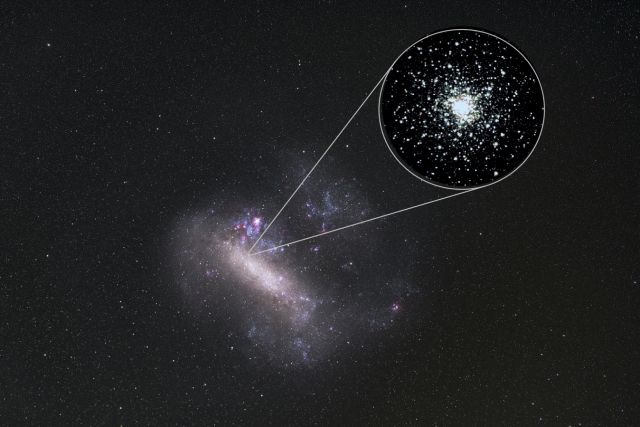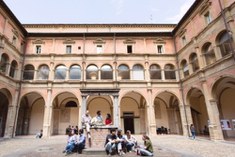Satellite galaxies too grow by "eating" smaller galaxies

How do galaxies grow? By "eating" smaller galaxies. This process doesn't apply only to large galaxies merging with their satellite galaxies, but also to the latter which in turn attract and merge with smaller galaxies orbiting them. This unprecedented discovery was reported in a study carried out by researchers at the University of Bologna and the National Institute for Astrophysics (INAF) and published in Nature Astronomy.
Within the Large Magellanic Cloud – the largest satellite galaxy of the Milky Way – researchers have identified a star cluster, i.e. an extremely dense group of billions of stars, with chemical properties significantly different from other nearby clusters. Those properties differ so much from the other clusters that the possibility of those stars to have originated within their current galaxy is to be excluded. Therefore this single star cluster, dubbed NGC2005, must have developed in a small satellite galaxy and survived the accretion process onto the Large Magellanic Cloud.
"Galaxies eat other galaxies. This applies both to larger ones, such as our Milky Way, and to satellite ones such as the Large Magellanic Cloud. For the first time, we have been able to show that this process occurs at all levels," says Alessio Mucciarelli, first author of the study as well as professor at the Department of Physics and Astronomy "Augusto Righi" of the University of Bologna and INAF member. "The star cluster we identified within the Large Magellanic Cloud probably originated from a dwarf spheroidal galaxy similar to those observed today within the Local Group which is the galaxy group that also includes the Milky Way".
When a smaller galaxy is incorporated into a larger galaxy, its structure is entirely destroyed, and its stars become part of the larger galaxy. How is it possible then to distinguish the stars that originated in a certain galaxy from those that were merged afterwards? The answer lies in the different types and amounts of metals composing the stars. This characteristic can be thought of as a type of DNA that allows researchers to recreate the star genealogy.
Using high-resolution observations provided by the Very Large Telescope of ESO (European Southern Observatory) and the Magellan Telescope of Las Campanas Observatory, researchers analysed the chemical composition of eleven ancient star clusters identified within the Large Magellanic Cloud. Within the system called NGC2005, researchers found stars with properties significantly different from the others: the "stellar DNA" showed the different origin of NGC2005.
"NGC2005’s chemical properties clearly show its different nature. This cluster must have originated in a galaxy where stars are born at a considerably slower rate than in the Large Magellanic Cloud," confirms Davide Massari, researcher at INAF - Bologna and one of the authors of the study. "Therefore, this star cluster probably originated in a small satellite galaxy of the Large Magellanic Cloud that was later merged in."
In conclusion, NGC2005 is the living proof of the collision leading to the dissolution of its small galaxy of origin: so far, it is the only case among dwarf galaxies discovered by analysing their chemical composition. The results obtained confirm the hypothesis that galaxy formation processes are similar at all levels. This paves the way for new studies on these phenomena even outside the Milky Way.
The study was published in Nature Astronomy under the title "A relic from a past merger event in the Large Magellanic Cloud". The three scholars from the University of Bologna and INAF members participating in the study are Alessio Mucciarelli, Alice Minelli and Francesco Rosario Ferraro from the Department of Physics and Astronomy “Augusto Righi”. The scholars from the National Institute of Astrophysics (INAF) are Davide Massari, Donatella Romano, Michele Bellazzini and Livia Origlia. Francesca Matteucci from the University of Trieste and INAF member also took part in the study.






